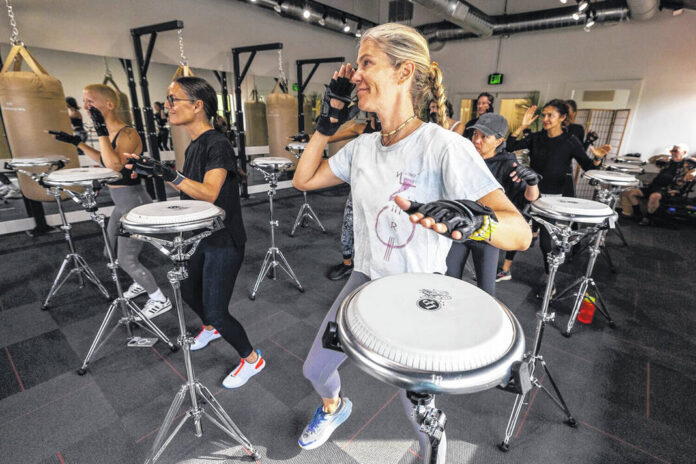
Drumboxing class members exercise with instructor John Wakefield mixing a combination of afro-cuban rhythms with standing drums and fundamental boxing techniques while applied to patterns, tempo changes, and commands to create a brain stimulating workout on Oct. 25, 2023, in Malibu, California.
Brian van der Brug/Los Angeles Times/TNS
LOS ANGELES — It’s an early Wednesday morning, and I’m about to work out — my noggin.
I’m at a “gym for the brain” in Malibu, readying for a group fitness class. It features a targeted aerobic exercise, performed to music, meant to develop focus, resilience and adaptability — all while torching calories.
The class is called Drumboxing, a new, so-called “brain fitness” technique developed by John Wakefield, a percussionist who plays with the Los Angeles Opera. He composed music, incorporating Latin and Afro-Cuban rhythms, that he combined with physical boxing moves and intricate, Simon Says-like patterns. The workout is meant to challenge your brain by switching up rhythm, tempo, meter and movement in an ever-fluid environment.
Wakefield has been teaching the technique, privately, to boxers and other athletes for more than a decade. He and his business partner, former pro beach volleyball player Christina Hinds, opened a studio for Drumboxing earlier this year and it’s caught on among locals, including several celebrities. Cindy Crawford and LeAnn Rimes are regulars; Gabby Reece has taken the class as well. So have moms, tech and entertainment executives, nearby Pepperdine University students and scores of others.
“People talk about elevating their heart rates in the class — some wear Apple watches — and it checks that box,” Wakefield says of Drumboxing. “But almost always, the first comment is: ‘Oh, I didn’t think about anything else while I took this class — the emails I had to answer or what meetings I had to go to — I was able to focus and be present.’ People like the brain engagement.”
The Drumboxing studio is nondescript, a former Pure Barre space in Malibu Country Mart that’s flooded with sunlight in the morning. But the setup is novel: there’s a grid of custom, free-standing conga drums, on adjustable-height steel frames, in the center of the room and a line of heavy bags, like boxers use, against a wall of mirrors. About a dozen of us wear lightweight mixed martial arts gloves to protect our hands and wrists.
We each claim a space between four standing drum heads, which we’ll pivot between doing shallow jumps and rhythmic twists while banging on the different drums. Wakefield gives us a short tutorial: “Focus on the rhythm. It’s all about the rhythm,” he says. Then, as the music starts up, he begins to hit his drum, slowly at first, creating numerical patterns we’re meant to follow with our hands and feet.
“1-2-1-1!” he yells, playing his conga heads. We take a wide stance, stepping side to side and banging in sync.
At first it’s easy and there’s a sense of camaraderie as we swivel and stamp collectively. But as Wakefield mixes up the patterns — calling out “Alt!” when we’re meant to pair opposite hands and feet or, later, asking us to follow the cues he gives us with his hands and not the conflicting cues he sends verbally — we inevitably fall out of sync. The scene devolves into what looks like a giant, three dimensional Rubik’s Cube, with individuals at the center of each quadrant spinning, messily, in different directions — all peppered with a healthy dose of laughter.
Our mistakes, however, are exactly the point of the exercise. Drumboxing is designed to induce mistakes, “to push you to a border of achievement and failure, floating back and forth,” Wakefield says. “And it’s about getting past those mistakes and learning to move forward rather than be perfect.”
The adaptability skill that Drumboxing hones can be applied in the real world, Wakefield says.
“You’re working on it in a fun, nonthreatening, game-like environment,” he says, “but you can take that skill — how to read and react to your environment when it’s not completely in your control, or even when it’s chaotic — into different environments.”
Drumboxer Vajra Kingsley, 33, says she was dyslexic as a child and workouts incorporating right-left coordination were difficult for her. “But Drumboxing, it’s not about getting it right,” she says. “It’s about understanding how your mind is reacting when you get something wrong. You come out of the class with a sort of physical and mental confidence.”






